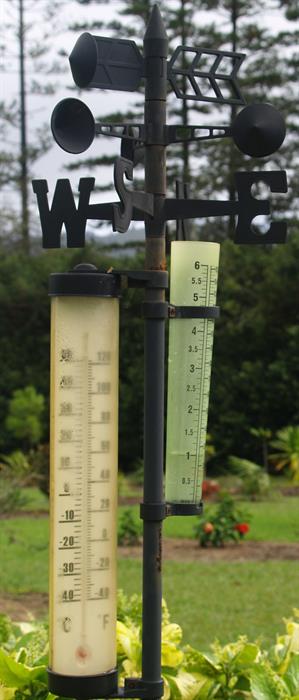
Learn how the climate works.
Climate science is a key foundation subject for horticulture, agriculture, and environmental management. It is a physical science; but one that biological scientists need to understand. Climate affects human health and well being, at one level; and much more at another level.
Course Content and Structure
There are eight lessons spread over 100 hours of study; as follows:
1. Nature and Scope of Climatology
- Introduction
- Understanding how climate and weather affects us
- What makes up weather?
- How do we measure weather?
2. Weather Science Foundations
- Solar Radiation
- Temperature
- Precipitation
- Deposition
- Humidity
- Clouds
3. Circulation Patterns
- Pressure Systems
- Atmospheric Pressure
- Pressure and Temperature
- Latitudinal Circulation
- Air masses
- Wind
- Trade Wind
- The Beaufort Scale of Wind Speed
- Frontal Systems
- Oceanic circulation
- Longitudinal Circulation
- Southern Oscillation
- Ocean Gyres
4. Climate Classifications & Patterns
- Types of Climates
- Arid or Desert
- Subtropical
- Tropical
- Temperate
- Mediterranean
- Coastal
- Factors Which Influence Climate
- Latitude
- Wind Direction
- Topography
- Altitude
- Aspect
- Geographical Location
- Climates Classification Models
- Koppen Climate Classification
- Thornthwaite Climatic Classification System
- Bergeron Climatic Classification System
- Spatial Synoptic Classification (SSC)
- Other Global Classification Systems
- Holdridge Life Zone System
5. Atmospheric Dynamics
- Introduction to Atmosphere Composition
- Purpose of the Atmosphere
- Seasonal Variations
- Vertical Structure of Atmosphere
- Precipitation
- Precipitation Processes and Other Events
- Cloud Dynamics
- Storms
- Thunderstorms
- Cyclones, Typhoons and Hurricanes
- Tornadoes
- METAR Codes for Precipitation Processes
- Aerosols and Climate Processes
- Indirect Effects of Aerosols
6. Climate Changes
- Factors that Cause or Influence Climate Change
- Natural Causes
- The Sun
- Earth's Orbit
- Earth's Axis
- Oceanic Circulation
- Oceanic Carbon Dioxide
- Magnetic Field
- Plate Tectonics
- Volcanic Activities
- Asteroids, Comets or Meteorite Impact
- Manmade Causes or Anthropogenic Influences
- Fossil Fuels
- Agriculture
- Deforestation
- Nitrous Oxide
- Other Pollution
- Different Types of Climate Change Events
- Glaciation and Ice Loss
- Flora and Fauna
- Ocean Warming and Sea Levels
- Permafrost
- Extreme Weather Events
- Zone Depletion
- Global Warming and the Greenhouse Effect
7. Applications of Climate Science
- Evolution of Methods and Techniques of Weather
- Forecasting

- Early Methods & Simple Techniques
- Modern Forecasting Approaches
- Synoptic (Traditional) Forecasting
- Numerical Weather Prediction (NWP)
- Statistical Methods
- Long and Short Range Forecasting
- Understanding Forecasting Models
- Simple Models
- Tropical Cyclone Forecast Model
- General Circulation MOdel (GCM)
- Regional Climate Modelling
- Collection and Applications of Weather and Climate
- Data
- Weather Mapping
- Satellite
- Radar
- Tropical Rainfall Measuring Mission (TRMM)
- Verification Methods
- Methods of Standard Verification
8. Climatology Problem Based Learning Project
- Management Processes
- Planning
- Organising
- Leading
- Controlling
- Business Plans - Preparing a Plan
- Decision Making
- What to Plan for
- Risk
- Risk Analysis
- Ways to Manage Risk
- PROJECT PLAN
Water and Climate
Water is an odourless, colourless substance made of atoms of hydrogen and oxygen that, bound together, make up molecules of H2O. These molecules move around and rearrange themselves depending on the temperature they are exposed to, forming one of the three main states listed below:
- SOLID - Ice
- LIQUID – Water
- GAS – Water vapour
No matter which states these molecules are found, they are constantly moving or vibrating. Molecules of ice are the ones most tightly bound together. When temperature rises, these molecules absorb heat and begin to separate (melting process begins), resulting in a liquid state.
If temperature keeps rising, the water molecules go through faster more vigorous movements, creating a wider space between molecules (evaporation), until the bonds have completely broken and the molecules can move around freely, resulting in a gaseous state (if the liquid is pure and at standard atmospheric pressure (1atm), then ‘boiling point’ should occur at 100oC and over). Some of the water molecules, such as those that have absorbed higher temperatures, are able to escape the surface.
Conversely, just as molecules absorb heat, they are also able to release it and form one of three states. The process from gas to liquid releases the same amount of energy (calories) as to when it is being absorbed, but going through a process of condensation as opposed to evaporation. During condensation, the molecules experience a type of ‘compression’ due to the cooling down occurrence caused from the energy that is being released.
This can relate to the formation of cloud droplets when there is enough moisture in the air; if the amount of moisture is too high, then storm clouds may begin to form. This same way, when the molecules are in a liquid state and the temperature decreases, the molecules release energy (cool down) and the process of freezing begins. During this transition phase, the molecules will continue to ‘crystallise’ (solidify) until ice is formed (if the liquid is pure and at standard atmospheric pressure (1atm), then ‘freezing point’ should occur at 0oC and below).
Solids can also pass directly into a gaseous state (without becoming liquid) by absorbing the same amount of energy (cal) as both melting and evaporation processes together; this phase is also known as sublimation (e.g. clouds that appear and quickly disappear).
On a global scale, the amount of precipitation occurring on different regions is influenced by presence of low or high pressure systems. This way, regions subtle to high pressure and diverging winds will generally be associated with dry weather conditions (e.g. regions with continuous presence of sub-tropical highs such as the Sahara and Kalahari desert or the dry lands in Australia, United States and Canada), while areas influenced by low pressure cells, converging winds and rising air (e.g. regions closer to the equator such as the tropical rainforests in Brazil and Africa - Amazon, Congo) are most likely to receive great amounts of precipitation.
However, not only prevailing winds and pressure systems stimulate the amount of rainfall occurring over different areas, but air composition (warmer air has a higher capacity for sustaining moisture than colder air), temperature, land and water are also main factors that can greatly contribute to precipitation variations. For example, large landmasses around the mid-latitudes receive less rainfall than areas of land surrounded by the coast in the same latitudes.
Humidity
Beyond the understanding of the relationship between each of the previously mentioned phases, it comes to a conclusion that water vapour is the most important gas in the atmosphere to comprehend when it comes to reading, analysing and interpreting atmospheric changes to understand the weather processes that arise along with them. In simple terms, ‘humidity’ is the amount of water vapour present in the air and there are 3 basic ways of measuring its content:
- Relative Humidity
- Dew Point
- Mixing Ratio
Clouds
The term cloud is basically referring to a mass of water vapour or ice droplets, along with other suspended particles, present in the air above the surface of the earth. Clouds are generally visible to human eyes with fluctuating shapes and densities.
Clouds are formed by cooling of humid air, which may be formed either by rising air currents (i.e. air currents moving from a region of higher pressure to a region of lower pressure) or by condensation (when a layer of air is cooled to dew point). Depending on the altitude where they are found, they may be classified in 3 different ways:
Low clouds (from 0 – 2 km high)
- Stratus (St): A uniform layer of clouds resembling ‘fog’, often covering a large area of the sky, usually dull grey in colour. Possible drizzles or very light precipitations may be produced.
- Stratocumulus (Sc): Long rolls, rounded sheets or lumpy patches parallel to one another, usually white or greyish in colour. Blue skies are visible in between these clouds. Only light drizzles may be produced.
- Cumulus (Cu): Large, globular puffy clouds, generally exhibiting a flat base (produced by the rise of moist, warm air), extending hundreds of metres across the sky. Normally bright white in colour with grey shade-like patches.
- They may produce little or no precipitation; however, they are often precursors of cumulonimbus clouds, which may then produce heavy rain, hail or snow.
- Cumulonimbus (Cb): This type of cloud produces strong thunderstorms with rain, lightning and hail, often accompanied by heavy turbulence and wind squalls or even tornadoes.
- Nimbostratus (Ns): Amorphous layers of dark grey clouds. One of the main producers of continuous precipitations or snow.
Middle clouds (from 2 – 7 km high)
- Altostratus (As): Uniform veils of grey or bluish-grey clouds, mainly composed of water droplets that may produce very light precipitation or drizzle.
- Altocumulus (Ac): White-grey puffy globular layer of clouds, resembling many cotton balls next to each other. These clouds can sometimes be found between warm and cold fronts. May develop thunderstorms.
High clouds (from 5 - 13 km high)
- Cirrus (Ci): White, thin-like strands of clouds across the sky. Composed mainly of ice crystals. They generally indicate arrival of precipitation; however, the ice crystals normally evaporate before hitting the ground.
- Cirrostratus (Cs): Thin and uniform veil of whitish clouds with a smooth appearance throughout the sky. Composed of ice crystals which may produce a halo (i.e. white arc of light in the sky) around the sun or moon. They may indicate an approaching frontal system.
- Cirrocumulus (Cc): A heaped-like layer of rippled, wave or globular clouds next to one another. Mainly composed of short-lived ice crystals which turn into cirrostratus, producing precipitation in the form of a virga (i.e. rain that evaporates before reaching the ground).